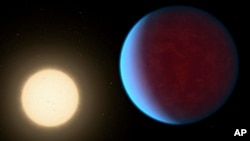A new NASA paper on exoplanets catalogs 126 confirmed and candidate exoplanets beyond our solar system, including some that could possibly support life.
The catalog, published May 23 by NASA’s Transiting Exoplanet Survey Satellite (TESS) with the W. M. Keck Observatory, measured the masses of 126 planet candidates. The scientists used the radial velocity method, which detects the "wobble" in a star caused by the planet's movement around it.
NASA program scientist Hannah Jang-Condell said the catalog is important because uncovering the mass and radius of a planet reveals its density.
“If the density is large, then it’s likely a rocky planet, like the Earth,” Jang-Condell told VOA via email. “If the density is low, it’s likely a gaseous planet, like Jupiter or Neptune.”
She added that understanding the measurements of the exoplanets helps scientists identify the best exoplanets to target to look for evidence of life. An exoplanet is a planet that orbits a star outside of our solar system.
David Latham, senior astronomer at the Harvard-Smithsonian Center for Astrophysics, told VOA that there haven’t been many discoveries of rocky planets surrounded by an Earth-like atmosphere.
“These sorts of results are available for a few dozen exoplanets at most,” Latham said in emailed comments. “So far none of them are true Earth twins, the size and mass of the Earth orbiting a star like the Sun, but we are gradually making progress towards that goal.”
NASA announced last month that researchers detected a thick atmosphere around a rocky planet called 55 Cancri e, which is one of the planets in the TESS-Keck survey catalog.
The exoplanet is twice the size of Earth and is 41 light-years away in a neighboring solar system.
Scientists used NASA’s James Webb Space Telescope to discover that atmospheric gases surrounded 55 Cancri e. The atmosphere of 55 Cancri e is made up of carbon dioxide and carbon monoxide, while Earth's atmosphere is a blend of nitrogen, oxygen, argon and other gases.
The planet is the “best evidence to date for the existence of any rocky planet atmosphere outside our solar system,” according to NASA.
Scientists say 55 Cancri e is not likely to host life because the planet can become as hot as 2,315 degrees Celsius (4,200 degrees Fahrenheit) and its surface is covered in magma oceans.
The planet orbits a sun-like host star called 55 Cancri A. But the discovery is a sign that potentially habitable rocky planets with dense atmospheres could exist.
Researchers identified the makeup of 55 Cancri e’s atmosphere by observing the planet before and after it moved behind its star. Scientists isolated the light emitted from the planet versus its star host and determined heat was distributed more evenly across the planet’s surface.
NASA planetary scientist Renyu Hu, who co-authored a paper on 55 Cancri e, told VOA that studying 55 Cancri e helps researchers improve their understanding of how gases behave on other planets.
“This way of measuring the thermal emission of planets and characterizing their atmospheres could be applicable to a handful of small, potentially rocky exoplanets,” Hu told VOA via email. “The candidate list could grow as the search for planets continues.”
The planet’s magma oceans may release gases which help hold its atmosphere. Researchers say 55 Cancri e might help explain how planets like Earth and Mars evolved first with magma oceans that have since cooled.
Some information for this report came from The Associated Press
